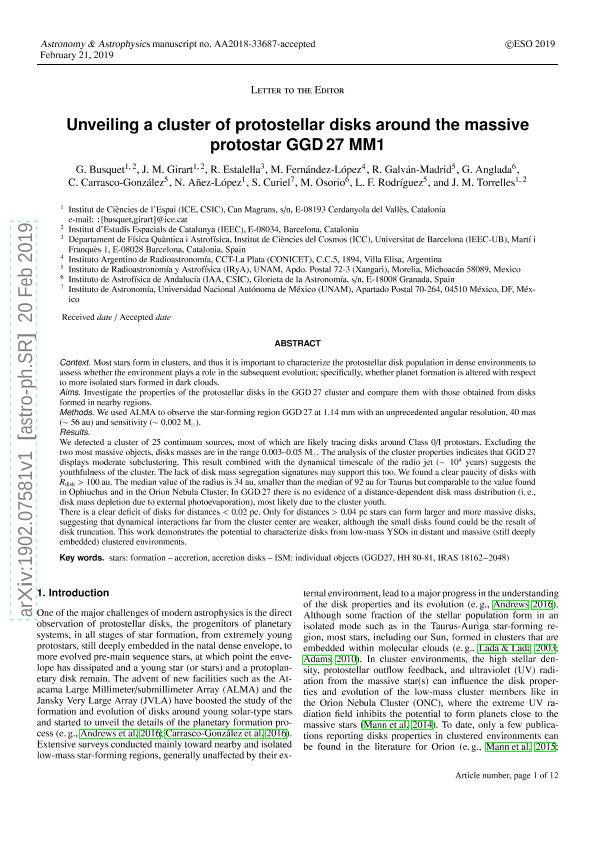Mostrar el registro sencillo del ítem
dc.contributor.author
Busquet, G.
dc.contributor.author
Girart, J. M.
dc.contributor.author
Estalella, R.
dc.contributor.author
Fernandez Lopez, Manuel

dc.contributor.author
Galván Madrid, R.
dc.contributor.author
Anglada, G.
dc.contributor.author
Carrasco González, C.
dc.contributor.author
Añez López, N.
dc.contributor.author
Curiel, S.
dc.contributor.author
Osorio, M.
dc.contributor.author
Rodríguez, L. F.
dc.contributor.author
Torrelles, J. M.
dc.date.available
2020-05-28T15:51:58Z
dc.date.issued
2019-03
dc.identifier.citation
Busquet, G.; Girart, J. M.; Estalella, R.; Fernandez Lopez, Manuel; Galván Madrid, R.; et al.; Unveiling a cluster of protostellar disks around the massive protostar GGD 27 MM1; EDP Sciences; Astronomy and Astrophysics; 623; L8; 3-2019; 1-11
dc.identifier.issn
0004-6361
dc.identifier.uri
http://hdl.handle.net/11336/106138
dc.description.abstract
Context. Most stars form in clusters and thus it is important to characterize the protostellar disk population in dense environments to assess whether the environment plays a role in the subsequent evolution. Specifically, it is critical to evaluate whether planet formation is altered with respect to more isolated stars formed in dark clouds. Aims. We seek to investigate the properties of the protostellar disks in the GGD 27 cluster and compare these with those obtained from disks formed in nearby regions. Methods. We used ALMA to observe the star-forming region GGD 27 at 1.14 mm with an unprecedented angular resolution, 40 mas (∼56 au), and sensitivity (∼0.002 M·). Results. We detected a cluster of 25 continuum sources, most of which likely trace disks around Class 0/I protostars. Excluding the two most massive objects, disks masses are in the range 0.003-0.05 M·. The analysis of the cluster properties indicates that GGD 27 displays moderate subclustering. This result, combined with the dynamical timescale of the radio jet (∼104 years), suggests the youthfulness of the cluster. The lack of disk mass segregation signatures may support this as well. We found a clear paucity of disks with Rdisk > 100 au. The median value of the radius is 34 au; this value is smaller than the median of 92 au for Taurus but comparable to the value found in Ophiuchus and in the Orion Nebula Cluster. In GGD 27 there is no evidence of a distance-dependent disk mass distribution (i.e., disk mass depletion due to external photoevaporation), most likely due to the cluster youth. There is a clear deficit of disks for distances <0.02 pc. Stars can only form larger and more massive disksfor distances >0.04 pc. This suggests that dynamical interactions far from the cluster center are weaker, although the small disks found could be the result of disk truncation. This work demonstrates the potential to characterize disks from low-mass young stellar objects in distant and massive (still deeply embedded) clustered environments.
dc.format
application/pdf
dc.language.iso
eng
dc.publisher
EDP Sciences

dc.rights
info:eu-repo/semantics/openAccess
dc.rights.uri
https://creativecommons.org/licenses/by-nc-sa/2.5/ar/
dc.subject
ACCRETION, ACCRETION DISKS
dc.subject
ISM: INDIVIDUAL OBJECTS: GGD 27
dc.subject
ISM: INDIVIDUAL OBJECTS: HH 80-81
dc.subject
ISM: INDIVIDUAL OBJECTS: IRAS 18162-2048
dc.subject
STARS: FORMATION
dc.subject.classification
Astronomía

dc.subject.classification
Ciencias Físicas

dc.subject.classification
CIENCIAS NATURALES Y EXACTAS

dc.title
Unveiling a cluster of protostellar disks around the massive protostar GGD 27 MM1
dc.type
info:eu-repo/semantics/article
dc.type
info:ar-repo/semantics/artículo
dc.type
info:eu-repo/semantics/publishedVersion
dc.date.updated
2020-05-19T19:02:42Z
dc.journal.volume
623
dc.journal.number
L8
dc.journal.pagination
1-11
dc.journal.pais
Francia

dc.description.fil
Fil: Busquet, G.. Instituto de Estudios Espaciales de Cataluña; España. Instituto de Ciencias del Espacio (ice); España
dc.description.fil
Fil: Girart, J. M.. Instituto de Estudios Espaciales de Cataluña; España. Instituto de Ciencias del Espacio (ice); España
dc.description.fil
Fil: Estalella, R.. Universidad de Barcelona; España
dc.description.fil
Fil: Fernandez Lopez, Manuel. Provincia de Buenos Aires. Gobernación. Comisión de Investigaciones Científicas. Instituto Argentino de Radioastronomía. Consejo Nacional de Investigaciones Científicas y Técnicas. Centro Científico Tecnológico Conicet - La Plata. Instituto Argentino de Radioastronomía; Argentina
dc.description.fil
Fil: Galván Madrid, R.. Universidad Nacional Autónoma de México; México
dc.description.fil
Fil: Anglada, G.. Instituto de Astrofísica de Andalucía; España
dc.description.fil
Fil: Carrasco González, C.. Universidad Nacional Autónoma de México; México
dc.description.fil
Fil: Añez López, N.. Instituto de Ciencias del Espacio (ice); España
dc.description.fil
Fil: Curiel, S.. Universidad Nacional Autónoma de México; México
dc.description.fil
Fil: Osorio, M.. Instituto de Astrofísica de Andalucía; España
dc.description.fil
Fil: Rodríguez, L. F.. Universidad Nacional Autónoma de México; México
dc.description.fil
Fil: Torrelles, J. M.. Instituto de Estudios Espaciales de Cataluña; España. Instituto de Ciencias del Espacio (ice); España
dc.journal.title
Astronomy and Astrophysics

dc.relation.alternativeid
info:eu-repo/semantics/altIdentifier/doi/http://dx.doi.org/10.1051/0004-6361/201833687
dc.relation.alternativeid
info:eu-repo/semantics/altIdentifier/url/https://www.aanda.org/articles/aa/abs/2019/03/aa33687-18/aa33687-18.html
Archivos asociados
